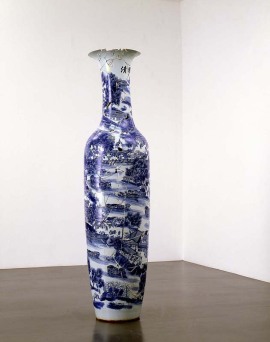

Vase plays on an intricate history of cultural and
economic exchange. Blue-and-white porcelain was originally a Mongol-influenced innovation and considered less desirable than monochromatic wares until it found favor with the imperial court of the Ming Dynasty (1369–1644). As porcelain became a key export commodity from China to Europe in the 16th century, a complex culture of appropriation and copying developed around the designs of blue-and-white porcelain—by both Chinese potters
of foreign imagery and foreign potters of Chinese imagery. Today, blue-and-whites are extensively counterfeited even as the originals soar in price: in 2005, a Yuan Dynasty (1279–1369) vessel sold for GBP 15.7 million (USD 23 million) at Christie’s in London.
Martin’s Vase, found in a shop in Ghent, Belgium, presents a typical Qing Dynasty (1644–1911) scene: traders gather in a city as boats float down an idyllic river dotted with bridges, trees and rocky embankments. After having been twice broken and reconstructed, the tableau takes on a very different character: Shards that are too small to be reconstituted are omitted, leaving gaps; the lip is precariously crumbling. The landscape slides into slow dereliction. Bridges decay, becoming increasing hazardous, boats are split i
n half and the immaculate landscape fractures along an ominous network of fault lines. As a political allegory, Vaserefers to the history of provincial power struggles that have historically plagued the Chinese nation, as well as to the dark and usually imperceptible fissures of uncertainty and corruption underlying today’s global networks of finance and trade. From an art-historical perspective,Vase is an obvious metaphor for the deconstructed nature of postmodern art. It proposes that the history of art can be messy, abrupt and counterintuitive: instead of celebrating artistic progress through innovation in porcelain-making, Martin’s audience is instead faced with recurring disas
ters and Sisyphean reconstructions.
Does Vase’s economic and art-historical value increase with each subsequent exhibition, as is generally the case in the art world, even as the object moves closer to complete disintegration with each public exposure? It would not be the first ceramic for which breakage actually increased its value: the Jesuit missionary Matteo Ricci, in his accounts of China in the 16th century, writes of porcelains that, once broken, became instantly more valuable by acquiring the patina of age. A decade prior toVase, Ai Weiwei photographed himself dropping a Han Dynasty (206BCE–220 CE) urn as an indictment of one of China’s most prized status symbols; ironically, Ai’s renowned photograph is today worth around $200,000—more than the urn ever was.
Vase has a definite but unknown lifespan: at the point where it disintegrates into too many pieces to be resurrected into an upright structure, Martin will not be able to topple it any further, and thus the work’s live quality will have come to an end. The piece edges closer to extinction with each exhibition, even as its exposure, and presumably price, increases. Does its value fall to zero at the
point when it can no longer be pieced together? From a different angle, how would an institution insure the work against third-party damage? If Vase were accidentally toppled by a museum-goer, could it be restored and, if so, how? It would be impossible to differentiate the cracks caused by accidental damage from those that Martin created.
Vase eloquently captures the impermanence and iconoclasm that are familiar traits of Martin’s contemporaries, but the work’s true distinction lies in the long-drawn-out psychological state of anticipation and wonder that it creates in its audience—an increasingly rare form of art appreciation. The public, arguably the main beneficiary of this conceptual work, finds itself in a uniquely voyeuristic position bordering on sadism: who doesn’t want to see how many times Martin can painstakingly slave over Vase before the entire enterprise crumbles? In an era of hypercommercialism and instant gratification, we are instead compelled to reverse-engineer clues among the traces of glue, and await history with the next fall.

No comments:
Post a Comment